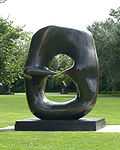Reclining Figure 1969–70
 Reclining Figure 1969–70 displayed in the Lola Beer Ebner Sculpture Garden at the entrance the Tel Aviv Museum of Art. | |
| Artist | Henry Moore |
|---|---|
| Year | 1969-70 |
| Type | Bronze |
| Dimensions | 343 cm (135 in) |
Reclining Figure 1969–70 (LH 608) is a bronze sculpture by English artist Henry Moore.
History
Inspired by the shape of a piece of flint, Moore created a maquette for the sculpture in plaster which was cast in an edition of small bronzes, some 15 centimetres (5.9 in) long. The maquette was used to create a full-size version in polystyrene, which was used to create a mould for a monumental sculpture.
The sculpture can be viewed as an abstraction of a reclining female human figure, resting on one arm, hip and two legs, with the second arm raised, and a prominence on the chest suggesting a breast. It has no obvious head or face.
Six full-size copies were cast in 1969 and early 1970, at the Noack factory in Berlin, and an artist's copy was cast shortly before Moore's death in 1986. The sculpture measures 3 × 3.6 × 2 metres (9.8 × 11.8 × 6.6 ft) and weighs around 2 tonnes (2.2 tons). One cast was exhibited in a major retrospective of his work at the Forte di Belvedere in Florence in 1972, later described by Moore as the pinnacle of his career.
The artist's cast, made in 1986, was stolen from the Henry Moore Foundation at Perry Green, Hertfordshire on 15 December 2005. It is believed to have been hoisted onto the back of a stolen flatbed Mercedes lorry using a crane, cut up for scrap the same night, and shipped to Rotterdam, and the probably to the Far East. The sculpture was estimated to be worth £3m, but only £1,500 as scrap. The theft inspired German artist Fritz Balthaus in 2009 to cast bronze ingots of equivalent weight which, arranged in a form approximating Moore's sculpture, are displayed as Pure Moore at the Federal Criminal Police Office in Berlin.[1]
Other casts are exhibited at the Louisiana Museum of Modern Art at Humlebaek in Denmark, the Hakone Open-Air Museum in Japan, and the Lola Beer Ebner Sculpture Garden at the Tel Aviv Museum of Art in Israel, one in South Africa, and two in private collections.
See also
References
External links
- £3m Henry Moore sculpture stolen, BBC News, 17 December 2005
- Image, Henry Moor Foundation
- Mystery of the stolen Moore solved, The Observer, Sunday 17 May 2009
- Lost Art: Henry Moore, Tate Gallery, 6 August 2012
- Mystery of the stolen Moore solved, The Guardian, 17 May 2009
- Israel Public Art
- Louisiana Museum of Modern Art, Henry Moore Foundation
- Hakone Open-Air Museum, Henry Moore Foundation
- Tel Aviv Museum of Art, Henry Moore Foundation
- Art theft: some of the famous art heists of the last 100 years, The Telegraph
- Celebrating Moore: Works from the Collection of the Henry Moore Foundation, p. 39-40
- Gallery of Lost Art
